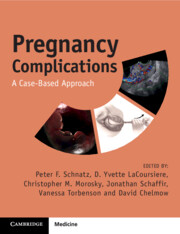Book contents
- Pregnancy Complications
- Pregnancy Complications
- Copyright page
- Contents
- Contributors
- Preface
- Note from the Editor-in-Chief
- Normal Laboratory Values (Conventional Units) []
- Section 1 Antepartum (Early Pregnancy)
- Section 2 Antepartum (Mid-trimester)
- Section 3 Antepartum (Late Pregnancy)
- Case 20 A Patient with Regular Painful Uterine Contractions at 32 Weeks
- Case 21 A 25-Year-Old Presents at 22 Weeks’ Gestation Leaking Clear Fluid
- Case 22 A 40-Year-Old at 34 Weeks’Gestation with Worsening Itching
- Case 23 A 25-Year-Old Presents at 30 Weeks’ Gestation Following a Motor Vehicle Accident
- Case 24 A 20-Year-Old Presents at 34 Weeks’ Gestation with Pruritic Abdominal Rash
- Case 25 A 30-Year-Old Presents at 18 Weeks’ Gestation with Severe Right Back and Flank Pain
- Case 26 A 30-Year-Old at 18 Weeks’ Gestation with Fever, Dysuria, Worsening Flank Pain, and Hydronephrosis
- Case 27 A 35-Year-Old with Abdominal Wall Bulge at 24 Weeks’ Gestation
- Case 28 A 30-Year-Old Presents for a Prenatal Visit at 41 Weeks’ Gestation
- Case 29 A 40-Year-Old Presents at 34 Weeks’ Gestation with Absent Fetal Movement
- Case 30 A 25-Year-Old at 36 Weeks’ Gestation Presents with Severe Bilateral Wrist Pain
- Case 31 A 20-Year-Old Presents at 31 Weeks’ Gestation with Severe Abdominal Pain and Constipation
- Section 4 Antepartum (Medical Complications)
- Section 5 Antepartum (Infectious Complications)
- Section 6 Intrapartum/Delivery
- Section 7 Postpartum
- Section 8 Fetal Complications
- Section 9 Placental Complications
- Section 10 Complications of the Cord, Amnion, and Gravid Uterus
- Section 11 Psychosocial Considerations
- Index
- References
Case 26 - A 30-Year-Old at 18 Weeks’ Gestation with Fever, Dysuria, Worsening Flank Pain, and Hydronephrosis
from Section 3 - Antepartum (Late Pregnancy)
Published online by Cambridge University Press: 08 April 2025
- Pregnancy Complications
- Pregnancy Complications
- Copyright page
- Contents
- Contributors
- Preface
- Note from the Editor-in-Chief
- Normal Laboratory Values (Conventional Units) []
- Section 1 Antepartum (Early Pregnancy)
- Section 2 Antepartum (Mid-trimester)
- Section 3 Antepartum (Late Pregnancy)
- Case 20 A Patient with Regular Painful Uterine Contractions at 32 Weeks
- Case 21 A 25-Year-Old Presents at 22 Weeks’ Gestation Leaking Clear Fluid
- Case 22 A 40-Year-Old at 34 Weeks’Gestation with Worsening Itching
- Case 23 A 25-Year-Old Presents at 30 Weeks’ Gestation Following a Motor Vehicle Accident
- Case 24 A 20-Year-Old Presents at 34 Weeks’ Gestation with Pruritic Abdominal Rash
- Case 25 A 30-Year-Old Presents at 18 Weeks’ Gestation with Severe Right Back and Flank Pain
- Case 26 A 30-Year-Old at 18 Weeks’ Gestation with Fever, Dysuria, Worsening Flank Pain, and Hydronephrosis
- Case 27 A 35-Year-Old with Abdominal Wall Bulge at 24 Weeks’ Gestation
- Case 28 A 30-Year-Old Presents for a Prenatal Visit at 41 Weeks’ Gestation
- Case 29 A 40-Year-Old Presents at 34 Weeks’ Gestation with Absent Fetal Movement
- Case 30 A 25-Year-Old at 36 Weeks’ Gestation Presents with Severe Bilateral Wrist Pain
- Case 31 A 20-Year-Old Presents at 31 Weeks’ Gestation with Severe Abdominal Pain and Constipation
- Section 4 Antepartum (Medical Complications)
- Section 5 Antepartum (Infectious Complications)
- Section 6 Intrapartum/Delivery
- Section 7 Postpartum
- Section 8 Fetal Complications
- Section 9 Placental Complications
- Section 10 Complications of the Cord, Amnion, and Gravid Uterus
- Section 11 Psychosocial Considerations
- Index
- References
Summary
Hydronephrosis and hydroureter, characterized by renal collecting system enlargement and ureteral distention, are common occurrences in pregnancy, affecting around 80% of pregnant individuals, more often prevalent on the right side. Detection through ultrasound usually occurs in the second or third trimester, resolving within 6 weeks postpartum. Compression of ureters by the uterus against the pelvic brim, compounded by hormonal effects, primarily contributes to hydroureter and hydronephrosis. While typically asymptomatic, stasis of urine increases the risk of pyelonephritis and preterm delivery. Distinguishing physiological and pathological dilatation remains debated. In rare cases, severe obstruction can cause acute hydronephrosis. Management focuses on conservative measures, fluid intake, pain relief, and addressing bacteriuria to prevent pyelonephritis. Procedural intervention is rarely necessary. However, if pathological factors like nephrolithiasis cause acute obstruction, prompt intervention may be needed.
- Type
- Chapter
- Information
- Pregnancy ComplicationsA Case-Based Approach, pp. 81 - 83Publisher: Cambridge University PressPrint publication year: 2025

